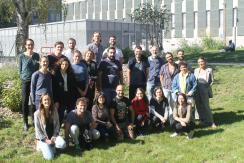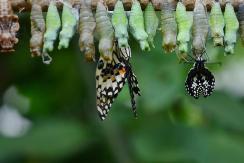COEVOL Multi-Scale Coevolution
Living systems are highly integrated, with a multitude of levels of organization, from molecular and intra-cellular scales to ecosystems. Complex organisms are themselves consortia of macro- and micro-organisms, which work together with their host to build the individual. Yet, each of these organisms can function and evolve in the short term according to its own logic, possibly in conflict with other higher or lower levels, or with other time scales. The once common idea among evolutionists that natural selection results in organisms perfectly adapted to their environment is now severely undermined. Not only because, as the Red Queen explains to Alice, one has to run relentlessly to keep its place in a changing environment, or because past evolutionary history and chance constrain the possibilities of present adaptation, but also because different levels of selection have interests that are generally difficult to reconcile.
Multi-scale coevolution resets classical questions in evolutionary biology
One example, of particular interest is the question of the source of heritable variations. The phenotype of organisms in a population is influenced not only by variations in their nuclear and mitochondrial genomes, the dynamics of which is the object of population genetics, but also more and more patently by the consortium of microbes and genetic elements that constitute its microbiome and virome. The hologenome designates this complex assembly of genetic materials, which obey different rules of transmission and different evolutionary strategies. The ability of symbionts to manipulate host phenotypes or to interfere with each other influences the evolutionary dynamics of all players in ways that are yet poorly understood. In addition, new questions arise, such as the importance of co-adaptation in these systems and their consequences in maintaining cohesive biological systems.
- Symbiosis: a response to and a source of divergent selection
Using a variety of approaches combining experimental evolution, genomic, functional, phenotypic and behavioral data, we aim to test whether symbiosis facilitates diversification and to characterize the underlying microevolutionary processes.
- Ecological networks of horizontal gene transfer
We develop original methods to detect gene transfer and we investigate the factors that influence the routes of gene transfers among microbes but also among insects.
- The interplay between symbiosis, infection and immunity and its evolutionary consequences
We try to understand the intimate interaction of hosts with pathogens, symbionts and transposable elements and how it affects the extended phenotype of the host.
- Transgenerational inheritance and environment changes
We try to decipher the molecular mechanisms that underlie rapid adaptation to environment and to test for transgenerational inheritance of fitness traits.
- Intragenomic conflicts and demography
We are developing models to test whether changes in the demography of the host affect the dynamics of transposable elements.
- The determinism of phenotypic convergence
We study the genomic basis of convergent phenotypic evolution in particular in the case of animals and plants adaptation to increasing temperature and decreasing water.
- Reconciling the tree of life
We develop phylogenetic methods for “reconciling” gene/species or host/symbiont histories and use these methods to explore the bulk of extinct or undescribed species and the history of association of symbiotic microbes with their hosts.
Integrating methods
The methods we use to tackle the questions raised by multi-scale co-evolution extend from theory, modelling and simulation to big data analysis, lab (notably on insects), and to a lesser extent, field activities.
Implication of research, responsibility of researchers and citizen sciences
From our research (some of which have immediate consequences in health, agriculture and ecology) and our concerns about the responsibility of scientists in society, we are committed to promote an “implicative” research. The implicative position means that we try to work on the link between science and society, not only through a one-way communication, applying or explaining our science, but also favoring early discussions on research projects, that may influence our research directions.
Publications
Display of 1 to 30 publications on 706 in total
Gene and transposable element expression in response to stress in temperate and tropical populations of Drosophila
Mobile DNA . 16 ( 1 ) : 35
Journal article
see the publicationEpigenetic Clock Analysis of Sex Chromosome Aneuploidies
Aging Cell .
DOI: 10.1111/acel.70243
Journal article
see the publicationGene flow can reveal ghost lineages
Evolutionary Journal of the Linnean Society . 4 ( 1 ) : kzaf014
Journal article
see the publicationMale sterility in Drosophila mojavensis × D. arizonae hybrids is not caused by gene movements in the Y chromosome
Evolution - International Journal of Organic Evolution .
Journal article
see the publicationA heritable RNA virus facilitates egg hatching of a parasitoid wasp
Annals of the Entomological Society of America .
DOI: 10.1093/aesa/saaf017
Journal article
see the publicationSummary of taxonomy changes ratified by the International Committee on Taxonomy of Viruses (ICTV) from the Animal DNA Viruses and Retroviruses Subcommittee, 2025
Journal of General Virology . 106 ( 7 ) : 002113
DOI: 10.1099/jgv.0.002113
Journal article
see the publicationTransposable element expression is associated with sex chromosome number in humans
PLoS Genetics . 21 ( 6 ) : e1011668
Journal article
see the publicationContinent-wide differentiation of fitness traits and patterns of climate adaptation among European populations of Drosophila melanogaster
Evolution Letters . : qraf014
Journal article
see the publicationExploring the Relationship of Transposable Elements and Ageing: Causes and Consequences
Genome Biology and Evolution . 17 ( 6 )
DOI: 10.1093/gbe/evaf088
Journal article
see the publicationHGTs are not SPRs: In the presence of ghost lineages, series of Horizontal Gene Transfers do not result in series of Subtree Pruning and Regrafting
Molecular Biology and Evolution . 42 : 1-6
Journal article
see the publicationTransposable elements as evolutionary driving force to host shift in cactophilic Drosophila species
Preprint
see the publicationmultistrap: boosting phylogenetic analyses with structural information
Nature Communications . 16 ( 1 ) : 293
Journal article
see the publicationBiais et faux semblants dans les études co-phylogénétiques : problèmes ou opportunités ?
Search for photosynthesis-related protein sites through chloroplast phylogenomics
ALPHY/AIEM 2025 .
Poster
see the publicationExploring the role of transposable elements to sex gap in longevity in Drosophila species
Preprint
see the publicationDating the origin of a viral domestication event in parasitoid wasps attacking Diptera
Proceedings of the Royal Society B: Biological Sciences . 292 ( 2039 )
Journal article
see the publicationFootprints of Worldwide Adaptation in Structured Populations of Drosophila melanogaster Through the Expanded DEST 2.0 Genomic Resource
Molecular Biology and Evolution . 42 ( 8 ) : msaf132
Journal article
see the publicationThe Silene latifolia genome and its giant Y chromosome
Science . 387 ( 6734 ) : 630-636
Journal article
see the publicationDo NSm Virulence Factors in the Bunyavirales Viral Order Originate from Gn Gene Duplication?
Viruses . 16 ( 1 ) : 90
DOI: 10.3390/v16010090
Journal article
see the publicationEpigénétique et Eléments Transposables
Epigénétique en écologie et évolution . 978-1-78948-216-4 : 95-116
Book chapter
see the publicationContribution of variable TE content on phenotype and plasticity in Drosophila melanogaster.
Annual meeting of the Society of Molecular Biology and Evolution (SMBE) .
Conference paper
see the publicationContribution of variable TE content on phenotype and plasticity in Drosophila melanogaster.
Conférence Jacques Monod Life is plastic .
Conference paper
see the publicationFunctional analysis of interactions between bed bugs and their symbionts Wolbachia and BEV-like
International congress of Ecology and Evolution (SFE2) .
Conference paper
see the publicationPhyloformer: Fast, accurate and versatile phylogenetic reconstruction with deep neural networks
Preprint
see the publicationSimulations of Sequence Evolution: How (Un)realistic They Are and Why
Molecular Biology and Evolution . 41 ( 1 )
Journal article
see the publicationEvolution and functional relevance of non-coding elements in vertebrate genomes
Intricate interactions between antiviral immunity and transposable element control in Drosophila
Preprint
see the publicationIdentification and quantification of transposable element transcripts using Long-Read RNA-seq in Drosophila germline tissues
Preprint
see the publication

